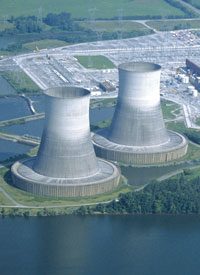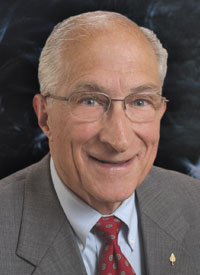
Interview of Art Crino by Rebecca Terrell Controversy over rising demands for “clean energy” and costs associated with it has made finding “alternative energy sources” a priority on Capitol Hill. The New American sat down with an expert in power-generation technology to discuss why nuclear is the safest, most efficient answer to the so-called “energy crisis.”
Art Crino, P.E., is a retired licensed electrical engineer. He began his career in design and construction of gas-fired steam electric and large hydro stations. He later managed factories that produced switching equipment for the electrical utility industry. Crino has authored many papers on power-generation issues. He lives in Tigard, Oregon.
The New American: Thank you for taking time to discuss energy sources. There is much controversy over electrical generation, largely due to negative publicity from the environmentalist lobby. Is there really a problem, and if so, what do you see as the solution?
 Art Crino: First, it needs to be made clear that CO2 is not a pollutant. It has a minuscule effect on Earth’s temperature, and vegetation of all kinds depends on it. The more the better. Records from 30 of the world’s most advanced economies show a positive correlation between CO2 emissions and increases in national income. There’s a similar correlation between per-person energy consumption and national income. Of course, CO2 isn’t the direct cause; the market economy causes the increase in energy use and emissions. But wealthier economies emit less per unit of production than developing nations, which translates to a cleaner environment and an economy prepared to control pollution.
Art Crino: First, it needs to be made clear that CO2 is not a pollutant. It has a minuscule effect on Earth’s temperature, and vegetation of all kinds depends on it. The more the better. Records from 30 of the world’s most advanced economies show a positive correlation between CO2 emissions and increases in national income. There’s a similar correlation between per-person energy consumption and national income. Of course, CO2 isn’t the direct cause; the market economy causes the increase in energy use and emissions. But wealthier economies emit less per unit of production than developing nations, which translates to a cleaner environment and an economy prepared to control pollution.
But there is a better alternative for electrical-power generation. The single greatest technological advance in recorded history was when we learned to make heat and electricity by converting mass to energy in nuclear reactors. This advance provided the safest, cleanest, and, except for hydropower, the most inexpensive and potentially most plentiful and useful energy in human history.
But the environmentalist lobby doesn’t like nuclear any more than it does coal-fired generation, mainly because it works! The alternatives they give are non-solutions. Take wind turbines that require some kind of back-up — usually gas turbines with very high fuel costs. European studies show that when about 5-10 percent of grid electricity is generated by wind, the grid becomes unmanageable because of constant fluctuations. Fluctuations are a part of balancing the grid, but most can be anticipated. Not so with wind.
Moreover, the peak electricity usage in most of the United States is on summer afternoons, the very time that wind is at its minimum. The highest winds come on winter nights, the very time when there is an excess of inexpensive base load power being produced. Without laws forcing utilities to use “renewable energy” and without “production tax credits” and other subsidies, wind turbines would be found mostly at amusement parks.
Ocean wave and solar technologies are equally incapable of providing a consistent source of affordable, reliable electrical energy and, like wind, have a following only because of the hefty government subsidies available. Without government handouts, they would quickly die out.
TNA: Are the gas turbines used as back-up for wind generation also subsidized?
Crino: Government subsidies caused the frenzy over natural gas in the 1990s. It was an open secret that private firms could obtain a fixed-price gas source for five years, a contract with the local power company for five years, and end up with the plant “written off.” The fully depreciated generating station is only five years old. All that construction was in part responsible for a significant increase in the price of natural gas. Now, many industries dependent on natural gas, such as fertilizer and plastic manufacturing, have moved to Mexico or Saudi Arabia where gas is cheaper.
TNA: Are there other “alternatives” aside from those you’ve discussed?
Crino: Of course, there is hydro power, which provides approximately 10 percent of United States electricity and at very low cost. But, there are no prospects for additional hydro sites and there are those actively working to reduce the existing installations.
TNA: If nuclear is the best solution, why is it not pursued in the United States? Aren’t other countries using it to their own advantage?
Crino: Nuclear technology was developed in the United States, but after many dec-ades it only provides 20 percent of U.S. electricity, while coal provides nearly 50 percent. The nuclear number would be much larger except for the hysteria over Three Mile Island and Chernobyl.
There are 104 operating commercial nuclear reactors in the United States, producing electricity 90 percent of the time. There are more than 440 commercial reactor plants, spread out over 31 countries, that supply 16 percent of the world’s electricity. France generates approximately 80 percent of its electricity by nuclear.
In 2006, German Chancellor Angela Merkel was hailed as the “Green Chancellor” for promising to rid her country of coal and nuclear power. Now she is actively supporting construction of 26 new coal-fired plants, as well as keeping nuclear plants operating. Italy has reversed its decade-long “no nuclear power” policy.
Worldwide there are 47 nuclear plants under construction plus 133 more planned for the next decade, for a total of 180. China has 14 reactors in process and has plans for 86 by 2020. Though nuclear generation of electricity was developed in the United States, plans are more modest.
TNA: Why the difference?
Crino: One explanation could be that most leaders in China are scientists, whereas the United States is led by lawyers. It’s all political. You hear, “If you elect me, I’m going to see to it we have more jobs.” If we let the rest of the world embrace nuclear power, the United States is going to be handicapped. How are you going to create new jobs when you’re letting other countries outstrip you in power generation? Electricity is crucial for advancing civilization. The Energy Information Agency projects that by 2030 the U.S. electrical demands will increase by approximately 45 percent.
TNA: Let’s talk about objections to nuclear. There are those who point out the history of cost overruns in construction of nuclear power plants. What do you say to that?
Crino: When the industry was new, cost overruns were common because there was no such thing as a standard reactor. Now reactors and reactor sites are pre-approved, which makes cost overruns a thing of the past. A selected location is approved with an Early Site Permit (ESP) from the Nuclear Regulatory Commission (NRC), and then the utility ordering the reactor selects a pre-certified design. The only thing left is the Combined Construction and Operating License, known as the COL. It’s true all this bureaucratic red tape makes the process take longer here than in China or Japan, where construction is usually completed in fewer than five years. But it is a more efficient process than the past. Finance charges should also be reasonable under this NRC pre-approval program.
TNA: What about environmentalist lawsuits?
Crino: Well, we’re going to have those, but the approval process makes those more spurious.
TNA: There’s also the “NIMBY Syndrome” (Not-In-My-Backyard). Could that stand in the way?
Crino: During the site approval process, delays by public action do not become very costly because the reactor can be ordered after site approval. The enviable performance record, low operating costs of the existing reactors, and recognition of the carbon-free character have had a positive public impact for nuclear. Remember, we already have 104 reactors running in this country with no fatalities and no injuries over many thousands of reactor-years.
The ironic thing is a coal plant can’t possibly meet the requirements for radiation of a nuclear plant because they’re much bigger emitters. The heavy metals of poisonous by-products don’t have a half-life, so they’ll stay around forever. But I don’t like to harp on that point because radioactive emissions from either coal or nuclear plants are nothing to worry about. People only worry because of lies from the environmentalist movement.
TNA: What about spent-fuel -problems?
Crino: This objection is entirely political. Russia, France, Japan, India, and Great Britain have been reprocessing their fuel since the late 1960s. There is a great economic incentive because there is more usable energy in the spent fuel than consumed while in service. Reprocessing depends on the availability of new uranium sources. For example, Canada does not reprocess because they have an abundant supply. But reprocessing reduces the volume of waste by about 80 percent.
Our politicians ignore this fact. In 1972, escalating regulations shut down the West Valley, New York, reprocessing center. President Jimmy Carter dismantled the center in Barnwell, South Carolina, in 1977. President George W. Bush later authorized another center in the same state, but President Obama closed it on June 9, 2009.
TNA: Others say there is not enough available nuclear fuel.
Crino: Current reserves are sufficient for 90 years, but this number is expected to increase for quite a few reasons. Reactor designs continually demonstrate improved efficiency. All light-water reactors now have uranium enrichment in the 3 to 4.5 percent range and are non-explosive, as weapons-grade uranium must be enriched to at least 90 percent U235.
France has developed a process to dilute the 90+ percent uranium bombs from Russia with uranium tailings to form 3-percent fuel for reactors — also non-explosive. Half of the fuel used in the U.S. nuclear stations is from France. The Russians have copied the process for their electric generating stations.
Ultimately breeder reactors could be employed with numerous economic advantages. The most important advantage is they multiply the existing fuel supply by a factor of at least 50 to 75 times. Few people realize that 25 to 40 percent of our power from nuclear plants comes from plutonium that is formed in the reactor during operation — and is completely free!
TNA: How do you overcome all the negative publicity so the public will embrace nuclear?
Crino: I just talk about economics now, because everybody believes the lies Al Gore has told about science. (Actually, Gore tends to ignore nuclear power instead of fighting it, which is a compliment to nuclear power.)
Let me tell you about some success we’ve enjoyed recently with the Oregon state legislature. The 2009 Oregon legislature introduced Senate Bill 80 with great fanfare. It was Oregon’s version of “cap and trade” and was to be Oregon Governor Kulongoski’s legacy as he approached the end of his second and final term. I met with SB 80 joint committee members to warn them of the economic effects of reducing energy use and carbon dioxide emissions. They each got a copy of the 2008 Cascade Policy Institute paper Oregon Greenhouse Gas Reduction Policies: The Economic and Fiscal Impact Challenges. I emphasized three points during our meeting. First, a one-percent increase in energy use is associated with a one-percent increase in national income. Second, a one-percent increase in CO2 emissions is associated with a 0.71-percent increase in national income. Lastly, since SB 80 called for a 10-percent reduction in CO2 emissions below 1990 levels by 2020, passing the bill would mean an approximate 11-percent decrease in income for the state. That was the end of SB 80! I think we can have the same type of success educating legislators about the advantages of nuclear power.
TNA: What’s a realistic expectation for sources of power generation in the near future?
Crino: The Nuclear Regulatory Commission has received applications for up to 28 new reactors at 18 locations. But the primary sources of U.S. electrical energy in the near future will likely be gas-fired turbines, large nuclear plants, and large coal plants.
Meanwhile, the government will continue to waste taxpayers’ money on wind, solar, and other so-called renewables. Various states have enacted “renewable portfolio standards” (RPS), setting up quotas of renewable energy that utilities have to include among their sources of power generation. If renewables were so great, utilities would adopt them voluntarily to help lower their costs. RPSs are sure to keep energy prices inflated and production inefficient.




